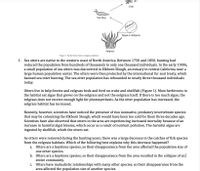
Human Anatomy & Physiology (11th Edition)
11th Edition
ISBN: 9780134580999
Author: Elaine N. Marieb, Katja N. Hoehn
Publisher: PEARSON
expand_more
expand_more
format_list_bulleted
Concept explainers
Question

Transcribed Image Text:Crab
Sea Slug
Algae on Eelgrass
Eelgrass
Figure 1. Partial food chain in eelgrass habitats
1. Sea otters are native to the western coast of North America. Between 1750 and 1850, hunting had
reduced the population from hundreds of thousands to only one thousand individuals. In the early 1900s,
a small population of sea otters was discovered in Elkhorn Slough, an estuary in central California near a
large human population center. The otters were then protected by the international fur seal treaty, which
banned sea otter hunting. The sea otter population has rebounded to nearly three thousand individuals
today.
Otters live in kelp forests and eelgrass beds and feed on crabs and shellfish (Figure 1). Most herbivores in
the habitat eat algae that grows on the eelgrass and not the eelgrass itself. If there is too much algae, the
eelgrass does not receive enough light for photosynthesis. As the otter population has increased, the
eelgrass habitat has increased.
Recently, however, scientists have noticed the presence of two nonnative, predatory invertebrate species
that may be colonizing the Elkhorn Slough, which would have been too cold for them three decades ago.
Scientists have also observed that otters in the area are experiencing increased mortality because of an
increase in harmful algal blooms, which occur as a result of nutrient pollution. The harmful algae are
ingested by shellfish, which the otters eat.
As otters were removed during the hunting years, there was a large decrease in the catches of fish species
from the eelgrass habitats. Which of the following best explains why this decrease happened?
Otters are a keystone species, so their disappearance from the area affected the population size of
one other species.
b. Otters are a keystone species, so their disappearance from the area resulted in the collapse of an|
entire community.
Otters have mutualistic relationships with many other species, so their disappearance from the
area affected the population size of another species.
а.
С.
Expert Solution
This question has been solved!
Explore an expertly crafted, step-by-step solution for a thorough understanding of key concepts.
This is a popular solution
Trending nowThis is a popular solution!
Step by stepSolved in 2 steps

Knowledge Booster
Learn more about
Need a deep-dive on the concept behind this application? Look no further. Learn more about this topic, biology and related others by exploring similar questions and additional content below.Similar questions
- Draw a food web.arrow_forwardPlease assist with biology questionarrow_forwardBelow is a list of the 9 organisms for this case study. Which of these organisms compete for space on rocks in the intertidal? Select all that apply. Meet the Players Primary Producers-Generate their own food using energy from the sun Common coral weed-Red Algae Nori seaweed-Red Algae Black pine Red Algae Sessile Consumers Acorn Barnacles Mussels Gooseneck Barnacles Mobile Consumers Dogwhelk Ochre Sea Star chiton O nori seasweed O black pine O common coral weed mussels acorn barnacles O gooseneck barnacles O chitons O ochre sea stars O dogwhelksarrow_forward
- Soil Invertebrate Biodiversity, research question.arrow_forward__________ can increase biodiversity. Protecting land Limiting mates Changes in temperature Decreasing the food supplyarrow_forwardDeforestation can have many local effects. For example, is the amount of light that is reflected off of a surface. This is of importance because dark surfaces are required to absorb incoming light to maintain the local area's normal temperature. precipitation albedo mesoderm carotenoids reflectionarrow_forward
- Which drawing of the intertidal region correctly represents Balanus' fundamental niche with an oval and correctly represents the Balanus' realized niche with a rectangle? O Image A O Image B Image C O Image D A. B. C. D. Å 4arrow_forwardWrite short notes on H.C. heller's1971 chipmunks in sierra Nevada mountains (California)arrow_forwardWhat changes to the rules for Dinotefuran use were made by ODA to limit future bee kill incidents and were they appropriate?arrow_forward
arrow_back_ios
arrow_forward_ios
Recommended textbooks for you
 Human Anatomy & Physiology (11th Edition)BiologyISBN:9780134580999Author:Elaine N. Marieb, Katja N. HoehnPublisher:PEARSON
Human Anatomy & Physiology (11th Edition)BiologyISBN:9780134580999Author:Elaine N. Marieb, Katja N. HoehnPublisher:PEARSON Biology 2eBiologyISBN:9781947172517Author:Matthew Douglas, Jung Choi, Mary Ann ClarkPublisher:OpenStax
Biology 2eBiologyISBN:9781947172517Author:Matthew Douglas, Jung Choi, Mary Ann ClarkPublisher:OpenStax Anatomy & PhysiologyBiologyISBN:9781259398629Author:McKinley, Michael P., O'loughlin, Valerie Dean, Bidle, Theresa StouterPublisher:Mcgraw Hill Education,
Anatomy & PhysiologyBiologyISBN:9781259398629Author:McKinley, Michael P., O'loughlin, Valerie Dean, Bidle, Theresa StouterPublisher:Mcgraw Hill Education, Molecular Biology of the Cell (Sixth Edition)BiologyISBN:9780815344322Author:Bruce Alberts, Alexander D. Johnson, Julian Lewis, David Morgan, Martin Raff, Keith Roberts, Peter WalterPublisher:W. W. Norton & Company
Molecular Biology of the Cell (Sixth Edition)BiologyISBN:9780815344322Author:Bruce Alberts, Alexander D. Johnson, Julian Lewis, David Morgan, Martin Raff, Keith Roberts, Peter WalterPublisher:W. W. Norton & Company Laboratory Manual For Human Anatomy & PhysiologyBiologyISBN:9781260159363Author:Martin, Terry R., Prentice-craver, CynthiaPublisher:McGraw-Hill Publishing Co.
Laboratory Manual For Human Anatomy & PhysiologyBiologyISBN:9781260159363Author:Martin, Terry R., Prentice-craver, CynthiaPublisher:McGraw-Hill Publishing Co. Inquiry Into Life (16th Edition)BiologyISBN:9781260231700Author:Sylvia S. Mader, Michael WindelspechtPublisher:McGraw Hill Education
Inquiry Into Life (16th Edition)BiologyISBN:9781260231700Author:Sylvia S. Mader, Michael WindelspechtPublisher:McGraw Hill Education

Human Anatomy & Physiology (11th Edition)
Biology
ISBN:9780134580999
Author:Elaine N. Marieb, Katja N. Hoehn
Publisher:PEARSON

Biology 2e
Biology
ISBN:9781947172517
Author:Matthew Douglas, Jung Choi, Mary Ann Clark
Publisher:OpenStax

Anatomy & Physiology
Biology
ISBN:9781259398629
Author:McKinley, Michael P., O'loughlin, Valerie Dean, Bidle, Theresa Stouter
Publisher:Mcgraw Hill Education,

Molecular Biology of the Cell (Sixth Edition)
Biology
ISBN:9780815344322
Author:Bruce Alberts, Alexander D. Johnson, Julian Lewis, David Morgan, Martin Raff, Keith Roberts, Peter Walter
Publisher:W. W. Norton & Company

Laboratory Manual For Human Anatomy & Physiology
Biology
ISBN:9781260159363
Author:Martin, Terry R., Prentice-craver, Cynthia
Publisher:McGraw-Hill Publishing Co.

Inquiry Into Life (16th Edition)
Biology
ISBN:9781260231700
Author:Sylvia S. Mader, Michael Windelspecht
Publisher:McGraw Hill Education